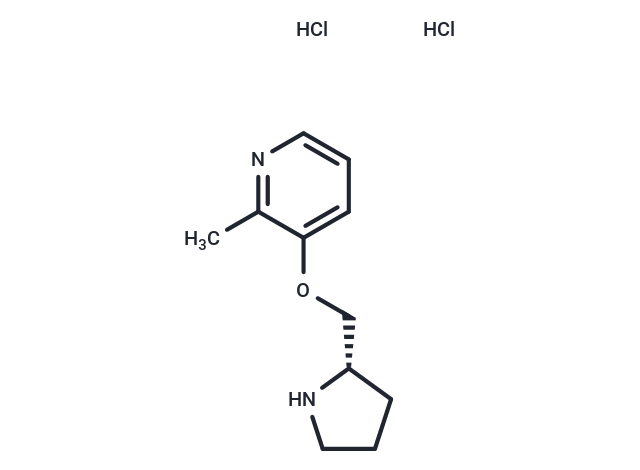Shopping Cart
Remove All Your shopping cart is currently empty
Your shopping cart is currently empty
Pozanicline dihydrochloride (ABT-089 dihydrochloride) is an orally bioavailable agonist of the nicotinic acetylcholine receptor (nAChR) with a Ki of 16.7 nM.

| Pack Size | Price | USA Warehouse | Global Warehouse | Quantity |
|---|---|---|---|---|
| 2 mg | $79 | 5 days | 5 days |
| Description | Pozanicline dihydrochloride (ABT-089 dihydrochloride) is an orally bioavailable agonist of the nicotinic acetylcholine receptor (nAChR) with a Ki of 16.7 nM. |
| Targets&IC50 | nAChR:16.7 nM(Ki), α6β2 nAChR:0.11 μM(EC50), α4β2 nAChR:17 nM(Ki,rat brain) |
| In vitro | Pozanicline is a partial agonist at α4β2 nAChR. Moreover, one α6β2 nAChR subtype is particularly sensitive to Pozanicline (EC50 of 0.11 μM)[2]. Pozanicline shows high selectivity for α6β2 and α4α5β2 nAChR subtypes[3]. |
| In vivo | ABT-089, a partial agonist of α4β2*, and ABT-107, an α7 nicotinic acetylcholine receptor agonist, for amelioration of cognitive deficits induced by withdrawal from chronic nicotine in mice.?Mice underwent chronic nicotine administration (12.6 mg/kg/day or saline for 12 days), followed by 24 h of withdrawal.?At the end of withdrawal, mice received 0.3 or 0.6 mg/kg ABT-089 or 0.3 mg/kg ABT-107 (doses were determined through initial dose-response experiments and prior studies) and were trained and tested for CFC.?Nicotine withdrawal produced deficits in CFC that were reversed by acute ABT-089, but not ABT-107.?Cued conditioning was not affected.?modulation of hippocampal learning and memory using ABT-089 may be an effective component of novel therapeutic strategies for nicotine addiction[3]. |
| Synonyms | ABT-089 dihydrochloride |
| Molecular Weight | 265.18 |
| Formula | C11H18Cl2N2O |
| Cas No. | 161416-61-1 |
| Relative Density. | 1.31g/cm3 |
| Storage | Powder: -20°C for 3 years | In solvent: -80°C for 1 year | Shipping with blue ice/Shipping at ambient temperature. | |||||||||||||||||||||||||||||||||||
| Solubility Information | H2O: 100 mg/mL (377.1 mM), Sonication is recommended. | |||||||||||||||||||||||||||||||||||
Solution Preparation Table | ||||||||||||||||||||||||||||||||||||
H2O
| ||||||||||||||||||||||||||||||||||||
| Size | Quantity | Unit Price | Amount | Operation |
|---|

Copyright © 2015-2025 TargetMol Chemicals Inc. All Rights Reserved.